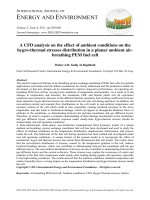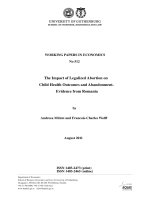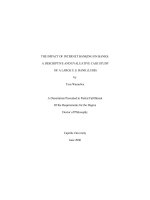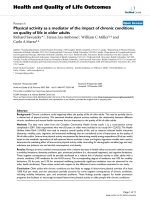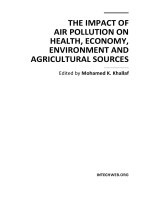Bạn đang xem bản rút gọn của tài liệu. Xem và tải ngay bản đầy đủ của tài liệu tại đây (371.9 KB, 7 trang )
<span class='text_page_counter'>(1)</span><div class='page_container' data-page=1>
<i>DOI: 10.22144/ctu.jen.2018.046 </i>
<i><b>Shelf-life evaluation of fresh catfish (Pangasianodon hypophthalmus) fillets at </b></i>
<b>different storage temperatures </b>
Tong Thi Anh Ngoc*<sub>, Phan Nguyen Trang and Ly Nguyen Binh </sub>
<i>Department of Food Technology, College of Agriculture, Can Tho University, Vietnam </i>
<i>*<sub>Correspondence: Tong Thi Anh Ngoc (email: ) </sub></i>
<b>Article info. </b> <b> ABSTRACT </b>
<i>Received 04 Mar 2018 </i>
<i>Revised 22 Jul 2018 </i>
<i>Accepted 30 Nov 2018</i>
<i><b> Shelf life of fish fillets from tra catfish (Pangasianodon hypophthalmus) </b></i>
<i>was evaluated on the basis of chemical, microbiological and sensory </i>
<i>quality during storage. The catfish fillets packed in polyamide package </i>
<i>combined with vacuum level of 60% were stored at 0, 4, 8, 12± 1.0°C. </i>
<i>The quality of packed catfish fillets was assessed at the regular time </i>
<i>in-tervals for a period of 25 days. The changes of quality were strongly </i>
<i>de-pendent on the storage temperatures. The shelf-life of catfish fillets stored </i>
<i>at 0, 4, 8, 12o<sub>C was, therefore, prolonged up to 21, 11, 7 and 3 days, </sub></i>
<i>re-spectively. In addition, total volatile basic nitrogen correlated well (r = </i>
<i>0.953) with the total microbial counts while the total microbial counts </i>
<i>also correlated well (r = 0.905) with lactic acid bacteria counts. </i>
<i>Howev-er, the weak correlation was shown between the total volatile basic </i>
<i>nitro-gen and the lactic acid bacteria counts (r = 0.087). The results obtained </i>
<i>can be used as a reference tool to improve fishery quality management </i>
<i>and to minimize the economic losses as well. </i>
<i><b>Keywords </b></i>
<i>Pangasianodon </i>
<i>hypophthal-mus, quality changes, shelf </i>
<i>life, temperature, Tra catfish </i>
<i>fillet </i>
Cited as: Ngoc, T.T.A., Trang, P.N. and Binh, L.N., 2018. Shelf-life evaluation of fresh catfish
<i>(Pangasianodon hypophthalmus) fillets at different storage temperatures. Can Tho University </i>
<i>Journal of Science. 54(8): 124-130. </i>
<b>1 INTRODUCTION </b>
<i>Pangasianodon hypophthalmus (tra fish or striped </i>
catfish) is a good source of various nutrients,
namely protein quality, fatty acid, minerals, etc.
<i>that are required for human health (Karl et al., </i>
<i>2010; Szlinder-Richert et al., 2011; Usydus et al., </i>
<i>2011; Ruiz-de-Cenzano et al., 2013). This has </i>
be-come appreciated by consumers from different
<i>markets all over the world. Up to date, </i>
<i>Pan-gasianodon hypophthalmus products, particularly </i>
frozen forms, are exported to 145 countries
(VASEP, 2014). Besides frozen tra catfish, thawed
tra catfish fillets considered as (re)fresh fillets have
become increasingly popular in exported countries.
Product quality and shelf life of fishery products,
rapid deterioration of fish are mainly caused by
microbiological spoilage, leading to reduced shelf
life and economic loss. Microbiological spoilage
can be manifested in visible growth, textural
changes or off-odors and off-flavors (Gram, 2010).
The production of these off-odors depends not only
on the intrinsic characteristics related to chemical
composition of fish, but also on the extrinsic
<i>pa-rameters of storage temperature (Olafsdottir et al., </i>
2006). In general, fish is kept in chilled storage and
preferable on ice. The storage temperature
influ-ences the growth of spoilage microbiology. More
<i>specifically, the growth of Pseudomonas spp., </i>
<i>Shewanella putrefaciens, and Psychrobacter </i>
<i>im-mobilis were promoted under chilled and iced </i>
<i>con-ditions (Gennari et al., 1999). In contrast, abusive </i>
temperature can create an optimal environment for
<i>strong microbiological spoilage such as </i>
<i>Photobac-terium phosphoreum or other microorganisms </i>
</div>
<span class='text_page_counter'>(2)</span><div class='page_container' data-page=2>
In addition to temperature, storage conditions (i.e.
aerobic storage, vacuum, modified atmosphere
packaging) also impact on the shelf life of fish
products. Modified atmosphere packaging (MAP),
which employs elevated CO2 and /or reduced O2
concentration, is commonly applied storage
meth-od to extend the shelf life of fishery prmeth-oducts. So
far, only one study determined the shelf life of
thawed tra catfish fillets stored under different
MAP conditions at 4o<i><sub>C (Noseda et al., 2012). On </sub></i>
the other hand, the commercial aquaculture of tra
catfish is still a young industry in Vietnam, which
partly explains the little information concerning the
<i>shelf life and the quality of tra catfish during </i>
stor-age, particularly with the fresh tra catfish. The
ob-jective of the present study was to investigate the
effect of temperature conditions on
microbiologi-cal, physicochemical and sensory quality of fresh
<i>tra catfish fillets during storage. </i>
<b>2 MATERIALS AND METHOD </b>
<b>2.1 Experimental set-up </b>
<i>Twenty-five kg of Pangasianodon hypophthalmus </i>
fillets were bought from a company, located in Hau
<i>Giang province, processing tra catfish for export. </i>
After purchasing, the tra catfish fillets were stored
in ice and transported in insulated boxes to the
La-boratory of Microbiology and Biotechnology of
Food Technology Department, Can Tho University
for further storage experiments within 1 hour. At
the laboratory, the fillets were washed in the batch
consisting of a ratio fish to ice was 1:2. After
drain-ing, each fillet ranged from 150 to 200 g was then
packed aseptically in PA (polyamide) package
combined with vacuum level of 60% by means of
vacuum packaging machine (Tecnovac 5100H,
Italy). PA packages in size of 19x16 cm and
thick-ness of 85 µm used for packing the samples were
supplied by Cam Dao Company (District 3, Ho Chi
Minh city, Vietnam). The control samples were
fillets without packaging, stored under air.
Consid-ering the importance of the quality and shelf-life
extension of fresh fish, this study was designed to
evaluate the effect of storage temperatures (0°C,
4°C, 8°C and 12°C) on fish quality. The packaged
fillets were stored under different simulated
tem-peratures by adjusting the temperature in the
re-frigerator at 0, 4, 8, 12 ± 1.0°C. The temperature of
refrigerators (Sanaky VH358W and Sanyo
MPR-414F, Japan) was adjusted at different temperature
levels accordingly. After adjusting the temperature
levels, the set-up temperature was regularly
checked from five to eight hours by thermometer.
The packaged fillets of tra catfish were stored in
the refrigerators at a set-up temperature for a
peri-od of 25 days. On a regular basis (day 0, 3, 5, 7, 9,
11, 13, 15, 17, 19, 21, 23 and 25 of storage), three
samples of tra catfish were randomly selected for
the assessment of pH, the total volatile compound
content, microbiological quality and sensory
quali-ty.
<b>2.2 Analytical methodology </b>
On a regular basis of storage periods, different
pa-rameters of pH, total volatile basic nitrogen
con-tent, microbiological analysis, and sensory quality
were determined in triplicate. The analytical
meth-odology was based on TCVN 8338:2010 (TCVN,
2010). pH was measured with a pH-electrode
(Met-tler Toledo, Schwerzenbach, Switzerland). Total
volatile basic nitrogen (TVB-N) was based on
steam distillation of an alkalized samples and
ab-sorbed by boric acid solution (1%) and further
ti-tration using sulfuric acid solution (0.1N) described
by Antonacopoulos and Vyncke (1989). For
mi-crobiological analysis, a 25 g composite sample
from different parts of each fillet sample was
trans-ferred aseptically to a stomacher bag by means of
sterile scalpels and tweezers. 225 ml of sterile
Maximum Recovery Diluent (MRD, Merck,
Darm-stadt, Germany) was added and the mixture was
homogenized for 1 minute. Further decimal
dilu-tions were prepared in MRD. The total mesophilic
counts and lactic acid bacteria counts were
deter-mined by pour plating the decimal dilutions on
Plate Count Agar (PCA, Merck, Darmstadt,
Ger-many) and on de Man Rogosa Sharpe agar (MRS,
Merck, Darmstadt, Germany) (with an additional
over layer), respectively. The pour plates were
in-cubated for 3 days at 37°C to determine the total
mesophilic and lactic acid bacteria counts. With
regards to sensory evaluation, there were nine
pan-elists that participated in the sensory tests. The
sensory evaluation was assessed using a scoring
scale from 1 to 5 including odor, color and texture
<i>(Meenakshi et al., 2010). </i>
<b>2.3 Statistical analysis </b>
All experiments were performed in triplicate. The
results of microbiological analysis of the fillets
were expressed as log CFU/g. Results are reported
as mean value ± standard deviation of these
tripli-cate analyses. Cross-correlation were tested by
means of the non-parametric Spearman rank order
<i>correlation coefficients (r) two tailed test (α = 0.05) </i>
in SPSS version 20 (IBM Inc., Chicago, Ill., USA).
<b>3 RESULTS AND DISCUSSION </b>
</div>
<span class='text_page_counter'>(3)</span><div class='page_container' data-page=3>
micro-bial growth and subsequently induced
physico-chemical and sensory changes.
<b>3.1 Effect of storage at different temperatures </b>
<b>on microbiological quality </b>
The evolution of total mesophilic counts and lactic
acid bacteria is showed in Fig. 1A and 1B,
respec-tively. The growth rate of those microbial counts
depended on the temperatures stored. During
stor-age, the lower temperature would have resulted in
the lower microbial evolution. The initial total
mesophilic count was 4.7 ± 0.1 log CFU/g at day 0
and on day 5 this level increased to 5.1 ± 0.1, 5.3 ±
0.0, 5.8 ± 0.3 and 7.0 ± 0.1 log CFU/g on samples
stored under 0, 4, 8 and 12o<sub>C, respectively. The </sub>
initial total mesophilic count was consistent with
<i>the previous study of thawed tra catfish (Noseda et </i>
<i>al., 2012; Tong Thi et al., 2016). The total </i>
meso-philic count upper limit of acceptability, which is
<i>7.0 log CFU/g for freshwater fish as tra catfish </i>
(ICMSF, 2002) was exceeded after 25, 15, 9 and 5
days of storage at 0, 4, 8 and 12o<sub>C, respectively. </sub>
Obviously, temperature is one of the factors that
affect greatly the growth rate of the microorganism
<i>(Dalgaard et al., 1997). On the contrary, the </i>
num-ber of lactic acid bacteria appeared somewhat no
lag phase during storage as the initial lactic acid
bacteria was 2.7 ± 0.1 log CFU/g followed by a
rapid increase to 3.2 ± 0.0; 3.6 ± 0.3; 3.9 ± 0.1; 4.0
± 0.1 log CFU/g on samples after 5 days of storage
under 0, 4, 8 and 12o<sub>C, respectively. The lactic acid </sub>
bacteria may result in cross contamination and
en-vironmental contamination during processing
<i>(Tong Thi et al., 2013). The present study, tra </i>
cat-fish fillets were packed in PA packages under
vac-uum of 60%. As a result, the lactic acid bacteria
became dominant towards the end of shelf life. A
strong correlation was observed between the total
<i>mesophilic counts and lactic acid bacteria (r = </i>
0.905). The lactic acid bacteria which are tolerant
to CO2 considered to dominating spoilage
organ-isms on MAP freshwater fish as tra catfish
<i>(Arkoudelos et al., 2007; Noseda et al., 2012).</i>
<b>A </b>
<b>B </b>
<b>Fig. 1: Evolution of total mesophilic counts (A) and lactic acid bacteria (B) of fresh tra catfish stored </b>
<b>at 0o<sub>C (◆); 4</sub>o<sub>C (); 8</sub>o<sub>C () and 12</sub>o<sub>C (◼). Bars represent the standard deviation of three </sub></b>
</div>
<span class='text_page_counter'>(4)</span><div class='page_container' data-page=4>
<b>3.2 Effect of storage at different temperatures </b>
<b>on physicochemical quality </b>
The evolution of TVB-N content and pH of tra
<i>catfish fillets samples stored at 0, 4, 8, 12</i>o<sub>C is </sub>
de-picted in Fig. 2A and Fig. 2B, respectively. The
initial pH was 6.72 and decreased slightly between
6.46 and 6.68 (Fig. 2A). Thereafter, the pH
in-creased throughout the storage period. The rate of
change in pH increased with the temperature
stor-age, i.e. pH of 6.43 (at 0o<sub>C), 6.48 (4</sub>o<sub>C), 6.58 (8</sub>o<sub>C) </sub>
and 6.92 (12o<sub>C) for a period of 5 days. The TVB-N </sub>
is a quality parameter indicating spoilage of fish
during storage (Connell, 1995). The TVB-N
<i>con-tent of tra catfish samples kept under different </i>
temperatures is depicted in Fig. 2B. Similar results
were observed in pH evolution, the TVB-N change
was higher at high temperature than at low
temper-ature. The value of TVB-N was 12.84 ± 0.81
mg/100g at day 0. At day 5, the TVB-N content
increased to 14.71 ± 1.21, 16.34 ± 0.81, 22.41 ±
1.85 and 30.58 ± 1.07 mg/100 g of tra catfish fish
during storage at 0, 4, 8 and 12o<sub>C, respectively. </sub>
Afterward, they continued to increase to 27-31
mg/100 g at the end of shelf life. The results
ob-tained can be explained that microbiological
growth with a shorter lag phase at higher
tempera-ture condition inducing the faster evolution of
TVB-N. As the TVB-N content was associated
with fishery product spoilage, an increase in the
TVB-N content in those samples indicated the
stage of substantial spoilage of the muscle
<i>(Masniyom et al., 2013). A noticed finding in the </i>
present study is the TVB-N content correlated well
<i>with the total mesophilic counts (r = 0.953). In </i>
contrast, a weak correlation was observed between
<i>the TVB-N content and lactic acid bacteria (r = </i>
0.087). It is suggested that the TVB-N can be used
as an index to predict the total microbial counts on
<i>tra catfish during storage. </i>
<b>A </b>
<b> B </b>
<b>Fig. 2: Evolution of pH (A) and total volatile basic nitrogen (TVB-N) (B) of fresh tra catfish stored at </b>
<b>0o<sub>C (◆); 4</sub>o<sub>C (); 8</sub>o<sub>C () and 12</sub>o<sub>C (◼). Bars represent the standard deviation of three independent </sub></b>
</div>
<span class='text_page_counter'>(5)</span><div class='page_container' data-page=5>
<b>3.3 Effect of storage at different temperatures </b>
<b>on sensory quality </b>
The results of sensory attributes (color, odor, and
<i>texture) of tra catfish fillets are shown in Fig. 3A, </i>
<i>3B, and 3C. Fresh tra catfish had white color, no </i>
off-odor and hard texture were therefore
consid-ered to possess very high acceptability (score of
4.6-4.7 at day 0). Among them, the samples stored
at 0o<sub>C were preferable with the highest score </sub>
com-pared to those other samples stored at higher
tem-perature (i.e. 4, 8 and 12o<sub>C) during storage time. </sub>
The differences in the quality scores during storage
conditions are possibly due to the effect of
temper-ature to the enzymatic and microbial activities in
fish samples, whereas low temperatures delayed
<i>the enzymatic and microbial activities. Graham et </i>
<i>al. (1992) also reported that fish quality maintained </i>
for 2 days (at 15°C), 4 days (5°C) and 10 days
(0°C) before becoming unacceptable for human
consumption. The sensoryquality, is normally
ap-plied in estimating the freshness of fish, had a
cor-relation with chemical and microbiological quality
<i>(Karungi et al., 2004). Moreover, the sensory and </i>
chemical quality agreed well with the
<i>microbiolog-ical quality (Ghaly et al., 2010). Therefore, in </i>
addi-tion to the sensory quality, the limits of
acceptabil-ity were based on chemical qualacceptabil-ity (i.e. TVB-N of
35 mg N/100 g) and microbiological quality (i.e.
total aerobic counts of 7 log CFU/g) as a tool to
<i>estimate the shelf life of fresh tra catfish during </i>
<i>storage. The shelf-life of tra catfish fillets stored at </i>
0, 4, 8, 12o<sub>C was up to 21, 11, 7 and 3 days, </sub>
re-spectively.
<b>A </b>
</div>
<span class='text_page_counter'>(6)</span><div class='page_container' data-page=6>
<b>C </b>
<b>Fig. 3: Sensory evaluation of color (A), odor (B) and texture (C) of fresh tra catfish during storage at </b>
<b>0o<sub>C (◆); 4</sub>o<sub>C (); 8</sub>o<sub>C () and 12</sub>o<sub>C (◼). Bars represent the standard deviation of three independent </sub></b>
<b>samples </b>
<b>4 CONCLUSION </b>
Temperature had a great impact on the shelf life of
tra catfish fillets stored in PA packaging with
vac-uum level of 60%. The use of low temperature
might retard the microbiological and
physicochem-ical changes, leading to decrease in spoilage and
prolongation of the shelf life of fresh tra catfish
fillets. The tra catfish stored at 0o<sub>C was observed </sub>
the optimal temperature for shelf life extension.
More importantly, the present study shows that
TVB-N value is valid quality index for prediction
<i>the microbiological quality of tra catfish fillets. </i>
<b>ACKNOWLEDGMENTS </b>
This research was funded by NAFOSTED,
Vi-etnam (FWO.2011.32). We would like to thank
Ms. Nguyen Thi Nghi for conducting experiment
and Le Duy Nghia for practical assistance.
<b>REFERENCES </b>
Antonacopoulos, N. and Vyncke, W., 1989.
Determina-tion of volatile basic nitrogen in fish: a third
collabo-rative study by the West European Fish Technologists'
Association (WEFTA). Zeitschrift für
Lebensmit-teluntersuchung und-Forschung A, 189(4): 309-316.
Arkoudelos, J., Stamatis, N., and Samaras, F., 2007.
<i>Qual-ity attributes of farmed eel (Anguilla anguilla) stored </i>
under air, vacuum and modified atmosphere
packag-ing at 0O<sub>C. Food Microbiology, 24(7): 728-735. </sub>
Connell, J., 1995. Methods of assessing and selecting for
<i>quality, In: Control of fish quality, Wiley-Blackwell </i>
(from 4th edition), p. 256 pages.
Dalgaard, P., Mejlholm, O., and Huss, H.H., 1997.
Ap-plication of an iterative approach for development of
a microbial model predicting the shelf-life of packed
fish. International Journal of Food Microbiology,
38(2): 169-179.
Gennari, M., Tomaselli, S., and Cotrona, V., 1999. The
<i>microflora of fresh and spoiled sardines (Sardina </i>
<i>pilchardus) caught in Adriatic (Mediterranean) Sea </i>
and stored in ice. Food Microbiology, 16(1): 15-28.
Ghaly, A.E., Dave, D., Budge, S., and Brooks, M.S.,
2010. Fish spoilage mechanisms and preservation
techniques: Review. American Journal of Applied
Sciences, 7(7): 859-877.
Graham, J., Johnston, W.A., and Nicholson, F.J., 1992.
Ice in fisheries. FAO Fisheries Technical Paper No.
331. Rome, Italy.
Gram, L., 2010. Microbiological spoilage of fish and
seafood products, p. 87-119, Compendium of the
Microbiological Spoilage of Foods and Beverages.
Springer.
ICMSF, 2002. Micro-organisms in Food 7:
Microbiolog-ical testing in food safety management. . Kluwer
Ac-ademic/Plenum Publishers, Londen, Great Britain.
Karl, H., Lehmann, I., Rehbein, H., and Schubring, R.,
2010. Composition and quality attributes of
<i>conven-tionally and organically farmed Pangasius fillets </i>
<i>(Pangasius hypophthalmus) on the German market. </i>
International Journal of Food Science & Technology,
45(1): 56-66.
Karungi, C., Byaruhanga, Y., and Muyonga, J., 2004.
Effect of pre-icing duration on quality deterioration
<i>of iced Nile perch (Lates niloticus). Food Chemistry, </i>
85(1): 13-17.
Masniyom, P., Benjama, O., and Maneesri, J., 2013.
Effect of modified atmosphere and vacuum
<i>packag-ing on quality changes of refrigerated tilapia </i>
<i>(Oreo-chromis niloticus) fillets. International Food </i>
Re-search Journal, 20(3): 1401-1408.
</div>
<span class='text_page_counter'>(7)</span><div class='page_container' data-page=7>
<i>status of the fish, Cyprinuscarpio at different storage </i>
temperatures. Journal of Biomedical Sciences and
Research, 2(4): 254-257.
Noseda, B., Islam, M.T., Eriksson, M., Heyndrickx, M.,
De Reu, K., Van Langenhove, H., and Devlieghere,
F., 2012. Microbiological spoilage of vacuum and
<i>modified atmosphere packaged Vietnamese </i>
<i>Pan-gasius hypophthalmus fillets. Food Microbiology, </i>
30(2): 408-419.
Olafsdottir, G., Lauzon, H.L., Martinsdóttir, E.,
Oehlen-schláuger, J., and Kristbergsson, K., 2006.
<i>Evalua-tion of shelf life of superchilled cod (Gadus morhua) </i>
fillets and the influence of temperature fluctuations
during storage on microbial and chemical quality
in-dicators. Journal of Food Science, 71(2).
Ruiz-de-Cenzano, M., Beser, U., Cervera, M., and De la
Guardia, M., 2013. Fast determination of fish mineral
profile. Application to Vietnamese panga fish.
Eco-toxicology and Environmental Safety, 95: 195-201.
Szlinder-Richert, J., Usydus, Z., Malesa-Ciećwierz, M.,
Polak-Juszczak, L., and Ruczyńska, W., 2011.
Ma-rine and farmed fish on the Polish market:
Compari-son of the nutritive value and human exposure to
PCDD/Fs and other contaminants. Chemosphere,
85(11): 1725-1733.
TCVN, 2010. Officially legal criteria for frozen Tra fish
<i>(Pangasius hypophthalmus) fillet established by </i>
Vi-etnamese Science & Technology Ministry. Reference
number: TCVN 8338: 2010.
Tong Thi, A.N., Noseda, B., Samapundo, S., Nguyen,
B.L., Broekaert, K., Rasschaert, G., Heyndrickx, M.,
and Devlieghere, F., 2013. Microbial ecology of
<i>Vi-etnamese Tra fish (Pangasius hypophthalmus) fillets </i>
during processing. International Journal of Food
Mi-crobiology, 167: 144–152.
Tong Thi, A.N., Samapundo, S., Devlieghere, F., and
Heyndrickx, M., 2016. Microbiota of frozen
<i>Viet-namese catfish (Pangasius hypophthalmus) marketed </i>
in Belgium. International Journal of Food
Contami-nation, 3(1): 17.
Usydus, Z., Szlinder-Richert, J., Adamczyk, M., and
Szatkowska, U., 2011. Marine and farmed fish in the
Polish market: Comparison of the nutritional value.
Food Chemistry, 126(1): 78-84.
VASEP, 2014. Vietnam Association of Seafood
Export-ers and ProducExport-ers.
</div>
<!--links-->

